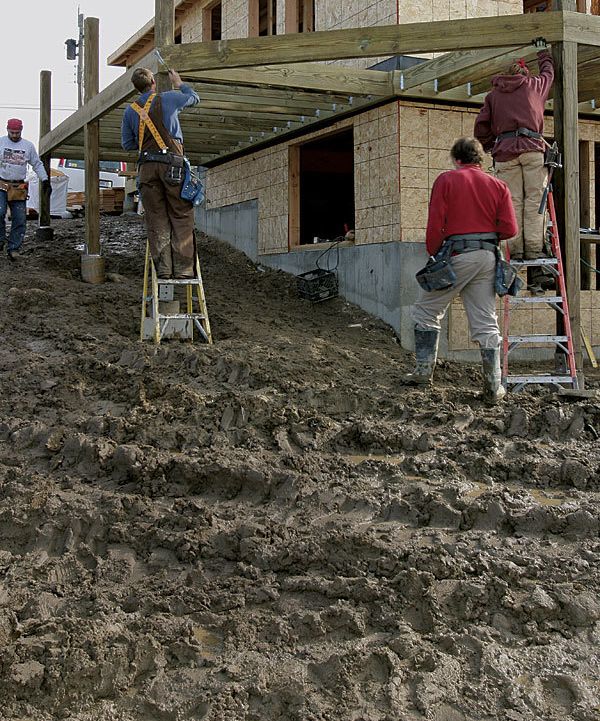
Synopsis: Mud from construction sites can flow into storm sewers and wreak havoc on the quality of streams, rivers, and other waterways. It also can annoy neighbors and result in steep fines. In this article, builder Fernando Pagés Ruiz recommends laying out a construction site in four zones to mitigate the effects of mud. Zone 1 establishes a perimeter by keeping as much vegetation as possible, then using silt fence and wattles in places where vegetation has been removed or disturbed. Zone 2 protects storm-water inlets through filtering sediment out of the water before it enters the inlets. Zone 3 sets up a material staging area to cleanly rid the construction site of excess water and concrete washout. Zone 4 creates clean access to the site by using either gravel or fabric mats. Builders who follow such practices have discovered an unexpected benefit: Customers assume that a tidy job site is indicative of the builder’s commitment to quality construction as well.
Drive past an average construction site (even a small residential addition) after a summer rain, and the street is usually coated with mud. Gooey, sticky, dirty stuff, the mud that runs off job sites and flows into storm sewers wreaks havoc on the quality of streams, rivers, and other waterways. But beyond the dire environmental consequences of job-site runoff, it’s also rude to mire your neighbors in mud. Plus, there’s the matter of steep fines.
It’s the law
Although most municipal ordinances include punitive measures for noncompliance, all the building officials I spoke with in my research focus on prevention through builder education and support rather than coercion. But they take the job seriously enough to prosecute those who don’t cooperate. Penalties for job-site pollution range from stop-work notices to thousand-dollar-a-day fines and even criminal prosecution.
“It’s a question of influencing the construction culture,” says Terry Ullsperger, a watershed-management inspector for Lincoln, Neb., who describes himself as someone who “has been on both sides of the silt fence.” Ullsperger likens the cultural conversion effort to the famous 1960s “Don’t Be a Litterbug” campaign, which made it unthinkable to toss trash from a car window. “Builders are slowly realizing a clean job site is just good building practice,” says Ullsperger.
Similarly, Janice Lopitz of the Keep It Clean partnership in Boulder, Colo., believes that those who would never wash a paintbrush in a stream bed may not realize they are doing the same thing when rinsing paint from their brushes at the curb. When you wash on the curb, the paint enters a storm-water inlet and heads straight to the nearest stream, lake, or river. “Whatever hits the street is as good as in the stream,” says Lopitz.
Big builders have been on notice for several years. Federal standards require a storm-water pollution-prevention plan when construction extends over an acre of land. This plan explains in detail what you will do to keep pollutants, principally mud, from seeping into the storm-water system. It requires an engineer’s stamp and inspection of mitigation methods every two weeks and after every storm. The plan also requires a living, breathing individual (not just a business entity) to become responsible and liable for the methods used, their maintenance, and their effectiveness.
Small sites are governed locally and increasingly require a permit with a simple plot plan illustrating the lot’s drainage pattern and the methods you will use to mitigate erosion, runoff, and pollutants.
Good housekeeping
Some builders have embraced the new job-site management practices and have discovered an unexpected benefit. “Customers notice a clean job site and assume our construction is as good as our housekeeping,” says Sean Smetter of Smetter Custom Homes in Lincoln, Neb. Smetter attributes at least part of his success in a tough economy to customers seeing his tidy job site as evidence of the quality consciousness they were looking for in a builder.
For more photos, illustrations, and details, click the View PDF button below:

























